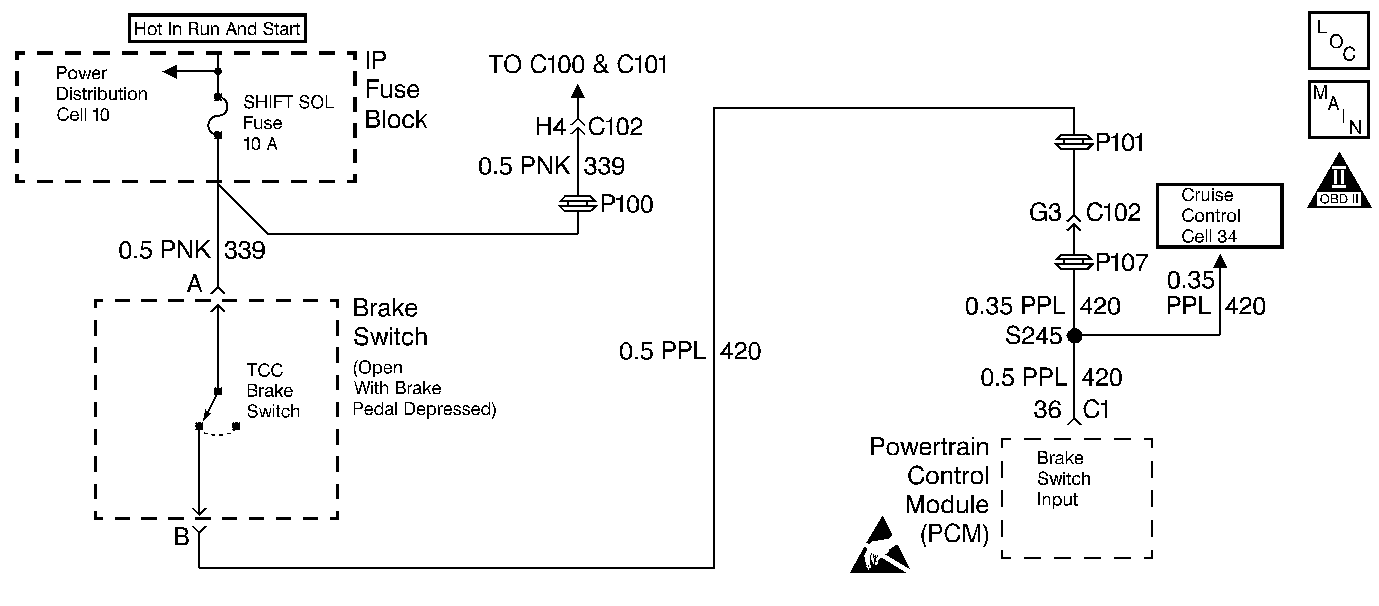
Circuit Description
The Torque Converter Clutch (TCC) brake switch is used to indicate the status of the brake pedal (applied or released).
When the Powertrain Control Module (PCM) detects a status change on the bake lamp switch and the extended travel brake switch input without a transition on the TCC brake switch input, then DTC P0724 sets. DTC P0724 is a Type C DTC.
Conditions for Setting the DTC
| • | No VSS DTCs P0502 or P0503. |
| • | No extended travel brake switch or stop lamp switch DTCs P1574 or P1575. |
| • | No loss of PCM serial data DTC P1602. |
| • | The traction control or ABS module has not failed. |
| • | The difference in vehicle speed and a non-driven wheel speed is less than 10 km/h (6 mph). |
| • | The TCC brake switch input indicates ignition volts. |
| • | DTC P0724 has not passed this ignition cycle. |
| • | The following conditions must occur 7 times without a status change on the TCC brake input: |
| 1. | Vehicle speed is greater than 32 km/h (20 mph) for more than 6 seconds. |
| 2. | Then the vehicle speed decreases to 8 km/h (5 mph) taking longer than 2 seconds. |
Action Taken When the DTC Sets
| • | The PCM does not illuminate the Malfunction Indicator Lamp (MIL). |
| • | SERVICE ELECTRICAL SYSTEM displays on the Driver Information Center (DIC). |
| • | The PCM uses the extended travel brake switch input or the stop lamp switch input for TCC control. |
| • | The PCM disables garage shift adapts. |
| • | DTC P0724 is stored in the PCM history. |
Conditions for Clearing the DIC/DTC
| • | The PCM turns OFF the DIC after three consecutive trips without a failure reported. |
| • | The brake switch input must indicate voltage OFF for 2 seconds. |
| • | A scan tool can clear the DTC from the PCM history. The PCM clears the DTC from the PCM history if the vehicle completes 40 warm-up cycles without a failure reported. |
| • | The PCM cancels the DTC default actions when the fault no longer exists and the ignition is OFF long enough in order to power down the PCM. |
Diagnostic Aids
| • | Inspect the TCC brake switch for proper adjustment. |
| • | Check the customer's driving habits. |
| • | Inspect the wiring for poor electrical connections at the PCM, the brake switch connector and all other circuit connecting points for the following conditions: |
| - | A bent terminal |
| - | A backed out terminal |
| - | A damaged terminal |
| - | Poor terminal tension |
| - | A chafed wire |
| - | A broken wire inside the insulation |
| - | Moisture intrusion |
| • | When diagnosing for an intermittent short or open, massage the wiring harness while watching the test equipment for a change. |
Test Description
The numbers below refer to the step numbers on the diagnostic table.
-
This step isolates the brake switch as the source for setting the DTC.
-
This step inspects circuit 420 for a short to power, if the scan tool status never changes from released to applied.
Step | Action | Value(s) | Yes | No | ||||||
|---|---|---|---|---|---|---|---|---|---|---|
1 | Was the Powertrain On-Board Diagnostic (OBD) System Check performed? | -- | Go to A Powertrain On Board Diagnostic (OBD) System Check | |||||||
Important: Before clearing the DTC(s), use the scan tool in order to record the Failure Records for reference. Using the Clear Info function will erase the stored Failure Records from the PCM. Did the display change from Closed to Open? | -- | |||||||||
3 | Replace the TCC Brake Switch. Refer to Brake Switch Replacement, Section 5. Is the replacement complete? | -- | -- | |||||||
Inspect circuit 420 for a short to power. Refer to Electrical Diagnosis, Section 8. Did you find and correct the condition? | -- | |||||||||
5 | Replace the PCM. Refer to PCM Replacement/Programming , Section 6. Is the replacement complete? | -- | -- | |||||||
6 | In order to verify your repair, perform the following procedure:
Has the test run and passed? | -- | System OK |
